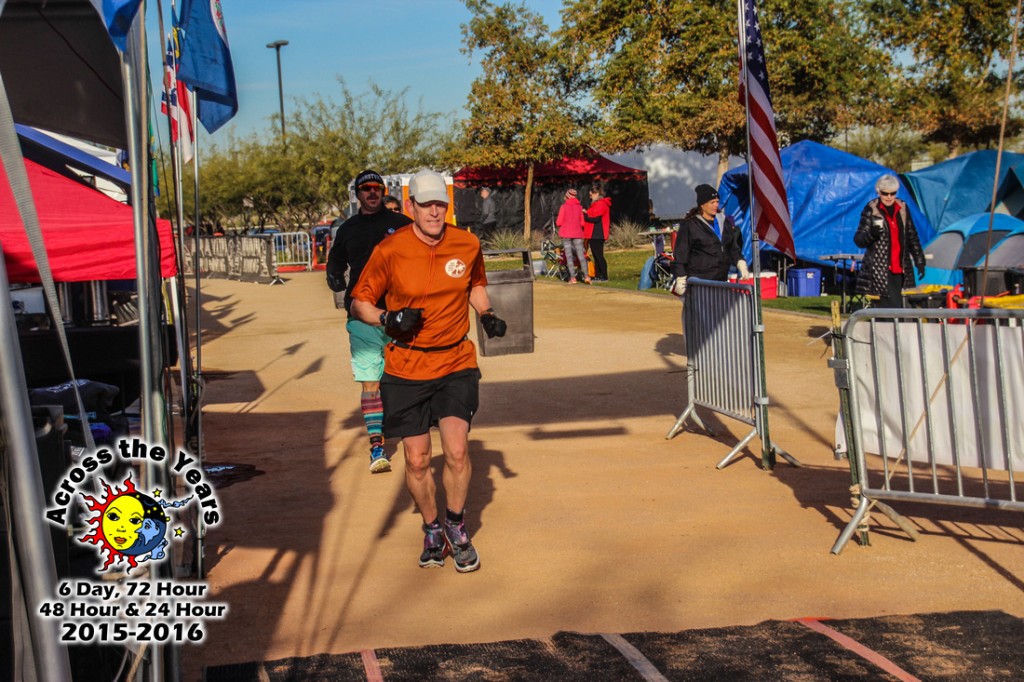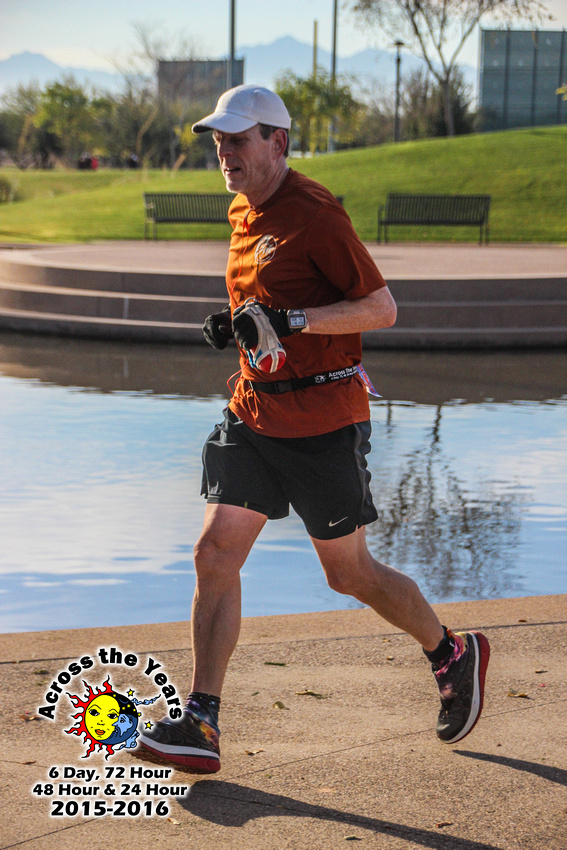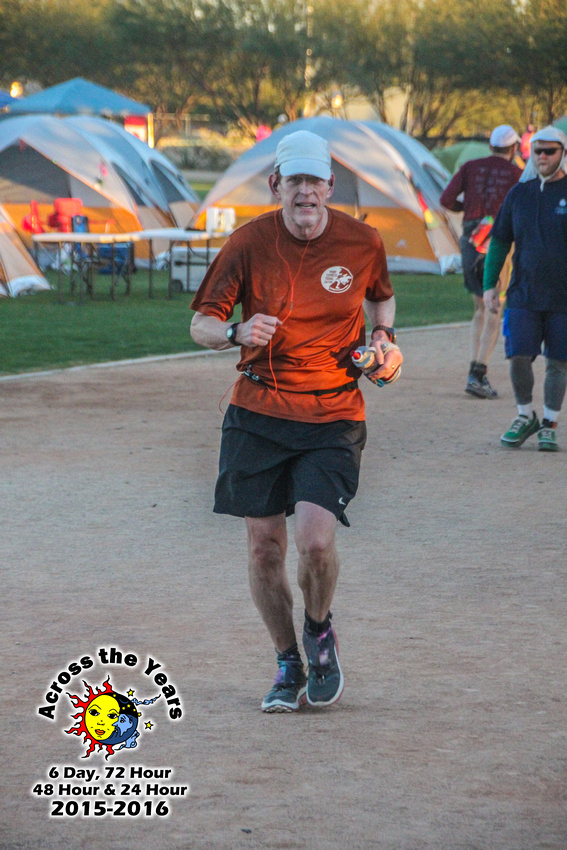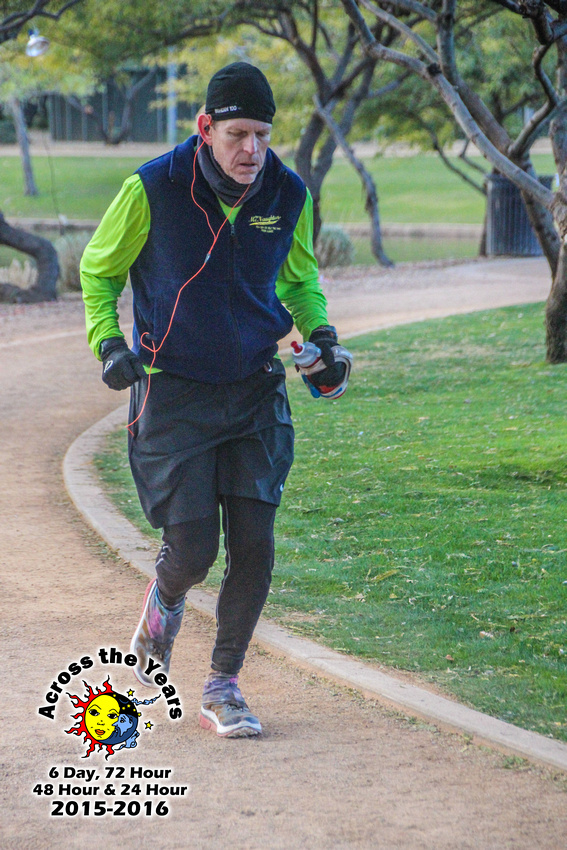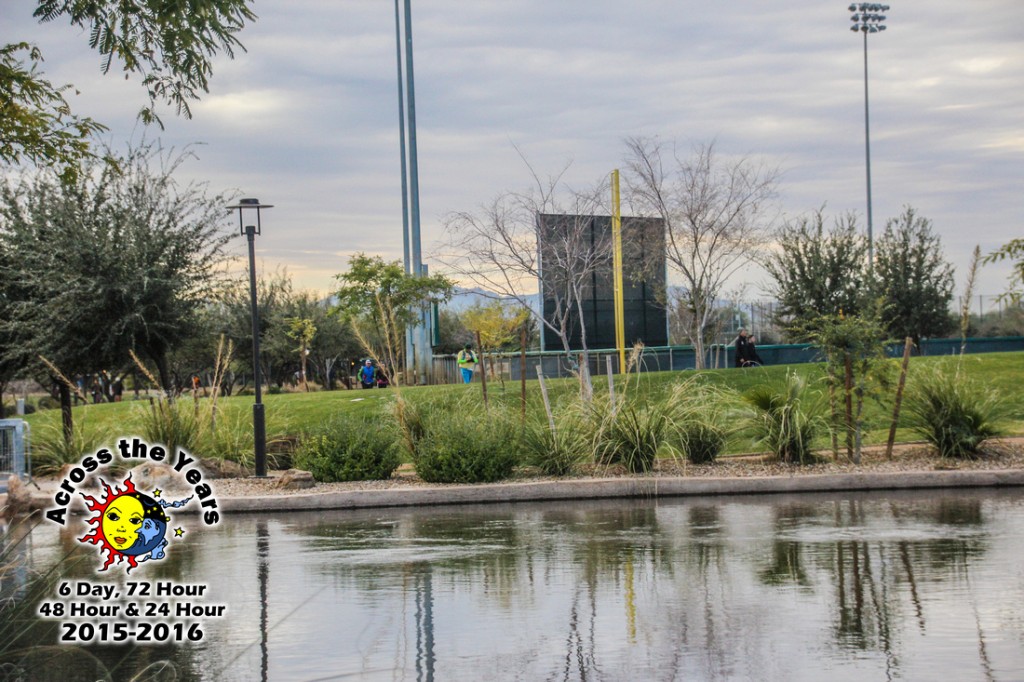To close out 2015, I again ran in Across the Years (ATY), a fixed-time race held in Glendale, Arizona at Camelback Ranch, the spring training facility for the Los Angeles Dodgers and the Chicago White Sox. Last year, after completing a 24-hour race there, I noticed that I was just 132.24 miles short of earning my 1,000 mile ATY jacket. I groaned, knowing that if I wanted it in one more year that I would need to enter the 48-hour race this year. Running for that long has been tough on me and I’ve come away injured after piling up miles before. But after an injury-free year, and solid training, I decided to go ahead and enter the 48-hour race.
At ATY, there are four different races, running concurrently, 24-hours, 48-hours, and 72-hours and an incredible six-day race. The objective is to run as many miles as you can during your time period. You can rest all you want, but the clock is always ticking. Many ultrarunner friends turn their noses up to these fixed-time races, running in circles for hours and hours. But to do well in these type of races requires mental strength and solid training, that for me transfers over to doing well in mountain 100-mile races.
This would be my 7th time running Across the Years and 4th time running in the 48-hour race. I’ve done well in the 48-hour race, finishing 1st, 2nd, and 4th in the past with miles of 187, 173, and 135. When I looked at the entrants for this year, I believed I could realistically compete for the win until Kelly Agnew, two-time winner entered. I was relieved because I could roll back my expectations, avoid more pain, and instead just concentrate on reaching 132.24 for the 1000-mile jacket. Still, I wanted to have a good showing.
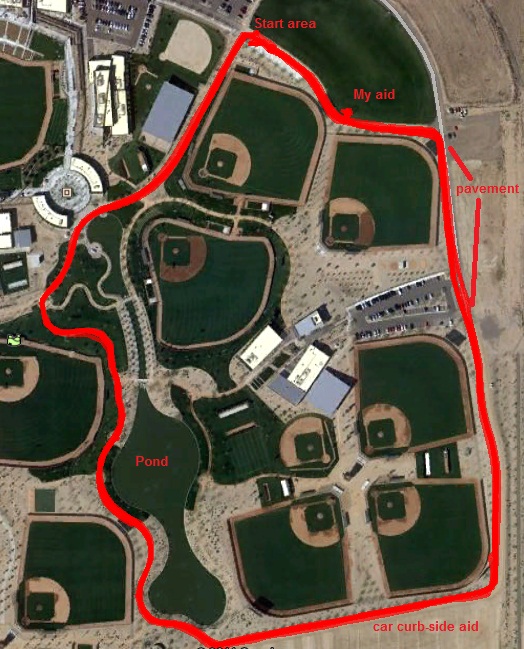
The 1.05-mile course is a nice loop through the baseball ranch that last year attracted nearly 150,000 fans to watch the Los Angeles Dodgers spring training games. The surface is a combination of pavement and dirt. The support for the race is top-notch and each year gets better with the attention to detail. My brother, Bob would be running again with me and we arrived the afternoon before and set up a table for our personal aid station. Bob hoped to reach 100 miles this year. Last year in the 24-hour race he reached 99.2 and came up short, so this time he also entered the 48-hour race to make sure the time didn’t run out on him.
This year would be a cold year. For me cold is usually better than hot, but the nights can be really tough as the temperature falls. The temperature was about 32 degrees before the start, with frost on the grass. I got everything all ready for me, joked around with Matt and Anne Watts, and we were away at 9:00 a.m. I quickly jumped out into the lead to test my legs, get warmed up, and see how long I could hold a comfortable, fast pace.

My first two miles were the fastest I would run during the race, two 7:52 miles. I felt very good so kept the fast pace going. It would be about ten miles before another runner passed me, a 24-hour runner. I had prepared a pacing chart, showing goal times for each 10-lap segments, also showing my times for past years. I reached ten laps in 1:27, just three minutes off my fastest time at this point in 2011. I finally lapped my brother Bob, who was running very solid. I could tell that discouraged him a bit, but he was running solid, I was going out very fast.
My first mile slower than 9:00 pace was mile 16. I now shifted to try to keep miles faster than 10-minute pace. I was now lapping my competition for the 48-hour race and it was nice to see “1st” continually by my name on the electronic board as I completed each lap. I finished my 20th lap (21 miles) at 3:07, just seven minutes off my best pace here. My first mile over 10-minute pace occurred on mile 22 because of a stop to fuel up and make adjustments. But now I set my goal to keep the miles under 10:30 pace and to focus on reaching the marathon mark in under 4 hours.
All continued to go well, better than the past couple years which pleased me, despite my advanced age. I started lapping Bob more often and he was sounding discouraged. I reminded him that he was running solid and was probably in 3rd or 4th place. I reached the marathon mark (26.1) in 3:58, only about five minutes slower than my best split time here. My focus now, was to reach 50K before five hours.
My first mile slower than 10:30 pace occurred at mile 27, but I would continue to run solid for many more miles. I reached 50K at about 4:59, goal reached. My personal best was a 4:38 split time in 2010 while running in the rain. Next I set my sights on reaching 50 miles before sunset, hopefully in under nine hours.
All continued really well. I listened to music as I ran and would say quick hellos to friends as I passed by. At about mile 36, I needed a long 15-minute bathroom break. It was nice to also rest the legs for a few minutes.
I kept running forward. My mile times ranged from 9:18-10:47, very consistent. I was careful to not stop very often at the aid station or my chair and table. I completed the 40th lap (mile 42) at 7:09, 36 minutes off my very speedy 2010 time, but more than an hour faster than my slow year in 2013. My goal on my sheet was for 7:10, so I was right on schedule. I was flying around mile 41 but quickly detected that the lap counter short-changed me a lap somehow. I had the race director check and indeed it had skipped a lap, showing a 21-minute lap at mile 41 which was impossible. He kindly fixed it.
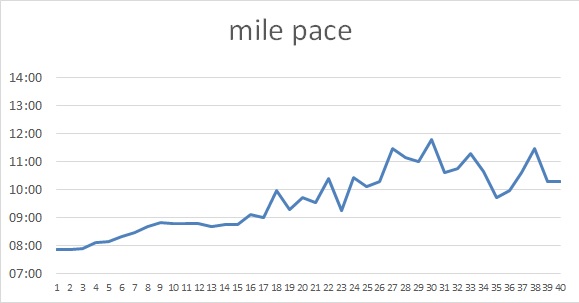
Bob started to really slow down and said he was going to quit. I tried to encourage him and suggesting he just rest for a while. My pace continued well as I approached 50 miles, but I noticed that Bob did pack up and leave. He again tried to do laps but could only walk and just didn’t feel the mental desire to continue. I would miss seeing him on the track and was sad about it. He would return in the evening to give me some encouragement.
I reached 50 miles in 8:40. I was very pleased. That was my fastest 50-mile time in four years. My best ever was 8:07 during this race. I was slowing as the sun set and it was getting cold. I now mentally set my sights on the 100K mark. I passed 100K (62 miles) at 11:10, a very solid time, not far off from my PR time, a split here in 2010 of 10:49. At the 12-hour mark, I was at about 66 miles. My best 12-hour split was 67.1 miles in 2010.
My fueling during the race came mostly fluids, diluted Ensure and Heed. I also ate some candy and some sandwiches and pizza offered by the aid station. Thankfully I never had any bad stomach problems. All continued to go well until mile 68. It was nearly 10:00 p.m. and now very cold. My pace degraded over 13 minutes for the first time and mentally I started to check out. I needed to warm up or bundle up more and just walk. For 68 miles, I had walked very little. I wanted to keep running, but just couldn’t keep up a pace to stay warm enough without putting on another layer.
I stopped. I went to the warm tent, put on long tights, and then went to my car to rest and warm up. This is what makes this race so mentally tough. If I would have checked my time, I would have seen that I was still seven minutes ahead of my aggressive goal, doing very well. But I needed to regroup. My stop was for 40 minutes and I shifted away from an aggressive goal for a 20-hour 100-mile split.
Back on the track again, I still had a good lead in the race, but I was struggling with wearing the right clothes to stay warm, but not sweat. After warming up again, my next two miles were 9:50 and 9:53 as I was again flying around the track, getting nice complements from the dwindling number of runners still out on the track during the night. But with each lap, my pace slowed. Foot and knee pain became pretty extreme and I made another couple stops of 20 and 25 minutes to again warm up and rest. To help with the boredom, I listened to ESPN Radio on my phone, but after a few hours of that, all the stories seemed to repeat.
I finished the 70th lap (mile 73.50) at 14:26, 24 minutes off my goal and about an hour slower than my best. Once passing mile 74, mentally I told myself there was just a marathon left before the 100-mile mark. I continued on with a consistent pace of about 14:30 and finished the 80th lap (mile 84) at 16:42 (1:42 a.m.), just 18 minutes off my aggressive goal.
But at about mile 86, it felt like I was out of gas and very cold. Instead of sitting in the car, I decided to just drive the five minutes to our motel room and actually lie down. For me, I know it is impossible to avoid sleep for 48-hours without bad consequences, so I could rest now or later. I chose now. It was about 3:00 a.m. I just plopped down on the bed, not planning to clean up, just rest. Bob was there and thanked me for waking him up. He wanted to get on the road to return to California. After he left, I tried to sleep, but it never came. However, the rest did well. Mentally, I came back and was still determined. At about 4:30 a.m., after a 95-minute stop, I was back running.
I was now sharing 1st place with Debra Horn, who I beat the last time we raced in 2010. It was now the coldest time of the night, at about freezing temperature. The speed didn’t return but I did manage three 12:30 miles until a really slow lap at mile 90. After another 30-minute break at the car, I was focused on getting to the 100-mile mark. It was now 6:45 a.m. and dawn arrived.
Things improved. I was again the fastest runner on the track as only a few other runners were truly running, not walking. My mile times were solid for this point of the race, between 12-13-minute miles. I reached the 100-mile mark at about 23:24 (GPS distance), much slower than my best here of 19:40. I celebrated to myself, knowing that it was my 11th 100-miler of the year and my 74th lifetime 100.
Matt Watts had been more than ten laps behind me, but because of my stops, he was now just one lap behind and was pushing hard to reach 100 miles and earn his buckle before his 24-hour deadline. We ran together with just a few minutes to go and we high-fived as he reached 100 miles with two minutes to spare at the half-lap mat. I had reached about 101.5 miles. My best ever for 24-hours was 117.8 miles in 2011. I tried not to think about how far behind I was off that mark and how I could have been close without all the stops.
I instead just thought about reaching 132.24, to get my 1,000-mile jacket. The day slowly warmed but it seemed like it would take forever to run another 30 miles. My pace now was between 14-15-minute miles with some fast ones below 11 as I tried to keep up with the Day-2 starters at times. The course was getting boring with the slow pace. The second day is always so hard. I no longer cared about my time or placement although I was still close to 1st place. I just wanted to reach 132 by dusk and then go sleep.
At mile 110, it was time for another break. I had still been running, but I knew I would slow to a walk without another rest. I didn’t want to walk for long stretches. My feet did so much better running. But my joints were screaming for rest. After 45 minutes, I was back on that track at 1:05 p.m. The afternoon slogged on. My pace became inconsistent, laps between 14-24 minutes. At about mile 125, I detected an issue that indicated that I was over-stressing my system. I decided to be smart and stop. It was 5:00 p.m., the 32-hour mark.
I feared that I was done, seven miles short of my goal. I gathered up many of my things in a bag, drove to get a burger, and then went to my motel room. Recovery was hard. I took a warm bath and shower, totally cleaning up, and then took much needed rest. Sleep didn’t come, but after three hours, I felt much better and really wanted to go finish off those last seven miles.
At 8:34 p.m., I was back on the track. I was now in 2nd place, behind Debra Horn by several miles. I had earlier had about a ten-mile lead on the next runner, but he was closing in now. My first mile went well, about 13-mile pace, but then I struggled again in the cold. After each lap I needed to stop to eat or drink, check my pace, and continue on. After seven miles, and a nearly 20-minute mile, I was done. I was at 132.3. I reached my goal of 1,000 miles. I was truly ready to quit. I gathered things up again and headed back to the motel. Again, I showered, totally cleaned up, went to bed, setting my alarm for 6 a.m. in order to do a few more slow miles in the morning.
Sleep came! At about 1:30 a.m., I woke up, checked the standings and noticed that I was now just a mile ahead of the next runner. I thought quickly about going to hold that lead, but instead went back to sleep. At 3:15, I again woke up and this time decided I was ready to run.
At 4:06 a.m. I was again running. I was in 3rd place, nearly ten miles behind the next runner. I calculated that if I ran hard for the next five hours, I knew I could catch him, but I didn’t really care that much. If he stopped to rest, it would be easily possible. Debra was twenty miles ahead, far out of reach. (She would go on to finish 170 miles and set a new American record for women aged 55-59.)
I started running and was pleasantly surprised how well-recovered I felt. My next eight miles were very consistent, at about 10:10 pace. On that dark track at this point in the race, that is truly flying. I was having a blast. Even though it was 28 degrees and my bottles were freezing solid on my table, I dressed just enough to stay warm, but not sweat. It required me to keep that consistent pace going. I lapped Debra three times during that time. I couldn’t determine who the other runner was ahead of me because he didn’t display his bib as he should, but by using the electronic board I determined that I was lapping him even faster and came within about four miles of him. But at mile 142, my legs and joints were screaming. I had to stop again. It was 6:00 a.m., with three hours to go. I should have been tougher and just walked several laps, but instead I warmed up and rested at the car for an hour.
At 7:06 a.m., I was back on the track for the last time. Again my pace was excellent. I hoped that the runner ahead who was going pretty slow would stop, but he didn’t. However again the lapping took place. As I ran at about 11-minute pace, I ran the numbers in my head and realized that I could reach a respectable 150 miles if I just maintained this fast pace for the entire two hours. When I stopped last evening, I never dreamed that I would reach 150 miles this year. But it now was possible.
The morning arrived, and runners poured back onto the track. Kind greetings and complements were given as I continued to fly by everyone. As the 48-hour mark got closer, I pushed even harder, realizing I could do an additional lap over 150. My last two miles were 9:28 and 9:39, the fastest miles I had run since mile 42. Clearly I left a lot of energy in the tank. I stopped with four minutes to go feeling very pleased at my strong finish. I failed to catch the runner ahead of me, who finished three laps ahead, but a few hours earlier he had been ten laps ahead, so I was really catching up fast.
Jamil Coury, the race director awarded me my 1,000-mile jacket and my 7th 100-mile ATY belt buckle. I had reached my main goal and was glad that I made a good solid effort.
Two days later, I found out that Kelly Agnew indeed won the 48-hour race with 171 miles and that he was bringing back for me the 3rd place men’s trophy, 4th including the women. There had been about 70 runners in the 48-hour race.
This was my 5th 48-hour race that I have completed, and the 6th time I have reached 150 miles in a race. But this, by far, was the oddest race I have ever run. As I looked at all my statistics, I determined that I was running on the track for only 31.5 hours! I had rested off-track for 16.5 hours. How in the world did I reach 151 miles with all that time away from the track? That means that while I was on the track, I was indeed running pretty hard during nearly the entire time. Thinking back, I never did walk more than a quarter of a lap at a time. Yes, a better approach is to pile up miles by walking long stretches like Debra Horn did to reach 171 miles, but mentally it is much easier for me to see the laps go by fast. I like to run fast. I ran 101 miles during the first 24 hours, and 50 miles during the next 24 hours. But for that second day, I was only on the track for about 11 hours so that is a respectable pace I kept up on Day 2.
On the positive side, at age 57, I’m still competitive at these long distances. My speed is still there with an 8:40 50-mile split. It just is a whole lot more work to maintain this level of speed and fitness than it was five years ago. I’ll be back to Across the Years. No, I have no plans at all to do the six-day race, that would kill me off and my bad leg could not hold up. Even the 72-hour is just too much for me. But I think I can still improve at 48-hours.




